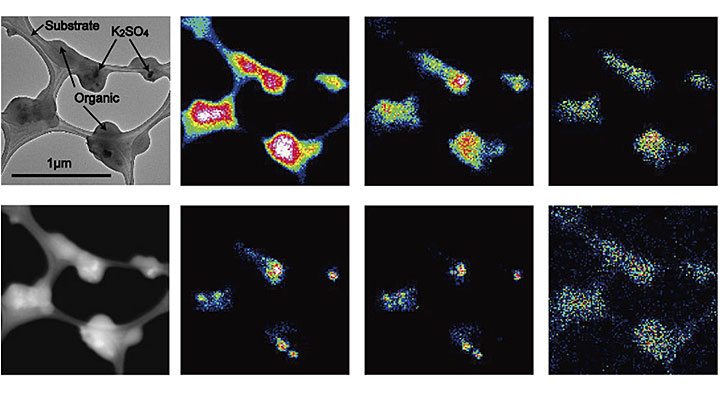Tiny Airborne Particles from Wildfires have Climate Change Implications
Chemical and microphysical analyses reveal formation processes for tarballs that result from emissions of biomass burned in wildfires
September 13, 2019
 enlarge
enlarge
Transmission electron microscopy images showing change of shapes and element distributions of biomass burning aerosol samples followed by aging. Credit: Arizona State University
The following is excerpted from a press release originally issued by Arizona State University.
Wildfires are widespread across the globe. They occur in places wherever plants are abundant — such as the raging fires currently burning in the Brazilian Amazon. Such biomass burning (BB) can be an environmental calamity.
The smoke from BB events produces large amounts of aerosol particles and gases. These emissions can cause major problems for visibility and health, as well as for local and global climate.
BB emissions are expected to increase in the future as a result of climate change. Tarballs, which are microscopic organic BB particles, are estimated to contribute up to 30% of BB aerosol mass. Because tarballs are a dominant, light-absorbing type of aerosol particle in BB smoke, understanding their influence on climate is crucial. But details of how they form and influence climate change have been unclear.
Senior researcher Kouji Adachi, currently working at the Meteorological Research Institute in Tsukuba, Japan, was a postdoctoral research associate from 2005 until 2011 with Professor Peter Buseck of Arizona State University’s School of Molecular Sciences and School of Earth and Space Exploration.
Their work attracted the attention of colleagues from the U.S. Department of Energy’s Brookhaven National Laboratory in Upton, New York. Principal investigators, Arthur Sedlacek III and Lawrence Kleinman, with support from the Atmospheric Sciences Program, were planning the Biomass Burning Observation Project (BBOP) field campaign, in which an instrumented airplane would measure rapid chemical changes in wildfire smoke.
Sedlacek and Kleinman approached Buseck about participating in BBOP, as the sampling strategy provided an ideal laboratory in the sky to study tarball formation.
The results, published online by the Proceedings of the National Academy of Sciences, show that tarballs form through a combination of chemical and physical changes of organic aerosols formed within the first hours following smoke production.
Tarballs used in this study were collected from large wildfires sampled during the BBOP campaign in the summer of 2013 in the northwestern United States. Using a Gulfstream-1 research airplane, the team collected wildfire aerosol particles on repeated flights through smoke plumes. Shapes and compositions of more than 10,000 particles were measured using transmission electron microscopy, with detailed chemical analysis of tarballs performed using scanning transmission X-ray spectroscopy.
The analysis reveals that the fraction of aerosol particles that are tarballs increases with particle age. In addition, the tarball ratios of nitrogen and oxygen relative to potassium, and the particle roundness, also increase with particle age.
BB emissions including tarballs are expected to increase in coming decades as a result of climate change. This study reveals their formation process through chemical and microphysical analyses. The findings can be used to provide better estimates of their effects in climate models.
The BBOP field campaign was sponsored by ARM, a DOE Office of Science User Facility.
Brookhaven National Laboratory is supported by the U.S. Department of Energy’s Office of Science. The Office of Science is the single largest supporter of basic research in the physical sciences in the United States and is working to address some of the most pressing challenges of our time. For more information, visit https://www.energy.gov/science/
Follow @BrookhavenLab on Twitter or find us on Facebook.
2019-16796 | INT/EXT | Newsroom









